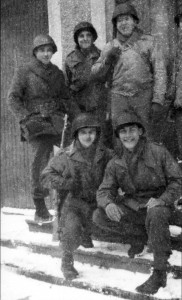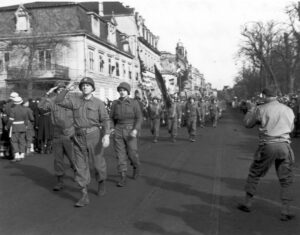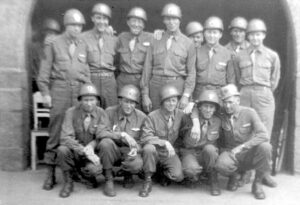When my father returned from WW II, he spoke very little about his experiences. Consequently, I knew almost nothing about his service. After his death, I contacted the military National Personnel Records Center in St. Louis; however, I was advised his records were lost in a fire at the center on 12 July 1973. All they could provide was a certification of his military service dates. I did locate his company executive officer, Captain William Pena, who had written his memories titled, As Far as Schleiden. I also corresponded with my dad’s company commander, Captain Bruce W. Paul. Much of the following summary was obtained from these two officers.

My father, Wilmer H. Gretzinger, entered the US Army on 7 March 1944. He was 32 years old. After basic training, he was sent to Europe and was assigned to the 28th Infantry Division, 109th Regiment, Company I. He arrived in England on 25 August 1944. PFC Gretzinger participated in four WW II campaigns. The first was in the Huertgen Forest, the second in the Ardennes (Battle of the Bulge), the third in the Liberation of Colmar, France and the last in Schleiden, Germany.
In early December 1944, the regimental commander, Colonel Jesse L. Gibney, of the 109th was replaced by LTC James Earl Rudder. The 3rd Battalion of the 109th Regiment held a position in Bettendorf, Luxembourg that was part of a 25-mile defensive line in this region of the Ardennes. Each of the three battalions of the 109th had about eight miles to defend. This distance, eight miles, was much too long to be adequately defended by one regiment, particularly in view of the German counterattack that began on 16 December.
In the first two days of the battle, Company I had lost one rifle platoon. Under intense enemy pressure, the 109th was ordered to regroup at Ettelbruck, about two miles further west. Because of heavy losses, the 3rd Battalion had to reorganize into three task forces– L, K and I. Task Force I was commanded by Captain Bruce W. Paul. He replaced First Lieutenant (1LT) Dulac, who was wounded on 2 November. Company I (my dad’s unit) was assigned to this Task Force. 1LT Tropp commanded Task Force K and Captain Fossum commanded Task Force L.
Task Force I took a defensive position about one mile east of Ettelbruck. The weather was so bad that the Allied planes could not support our ground troops. At first the battle went well for the Germans. They pushed the US 1st Army back creating a bulge in the line. This attack became known as the “Battle of the Bulge.”
However, the 110th Infantry Regiment of the 28th Division with 2,000 men stopped four German regiments with over 10,000 men. German Gen. Heinz Kokott later praised the 28th Division for delaying and stopping the German assault.
By 21 December, Company I was down to 50 men from an authorized level of 289. Allied reinforcements were brought in, and the weather cleared. Patton’s 3rd Army moved in to relieve the regiments of the 29th Division. Patton’s army would continue its move north to relieve the city of Bastogne, Belgium that was surrounded and under heavy attack by the Germans.
Relief of the 109th Regiment was completed on 23 December, and the regiment was ordered from Ettelbruck to Moestrof, Luxembourg. The commander of Company I, Captain Paul, was ordered to send a patrol into Moestrof to determine if the enemy was still in the town. The Germans, however, had evacuated the town so it was relatively quiet for the 109th for the next few days. Christmas Day, a Monday, for the regiment was a special day. As reported in Pena’s memories, the troops were served a turkey dinner with all the trimmings.
 Companies I, J and K of the 109th Regiment were on the move by truck from Moestrof to Sedan, France by way of Libramont, Belgium. My dad’s company (Co. I) arrived in Libramont on 27 December. The picture on the next page was taken in Libramont that day. Five men of Company I are in the photo. My dad is standing and is the first person on the right. Also standing is 1LT William Pena, the first man on the left. Pena was later promoted to Captain and served as the executive officer of Company I.
Companies I, J and K of the 109th Regiment were on the move by truck from Moestrof to Sedan, France by way of Libramont, Belgium. My dad’s company (Co. I) arrived in Libramont on 27 December. The picture on the next page was taken in Libramont that day. Five men of Company I are in the photo. My dad is standing and is the first person on the right. Also standing is 1LT William Pena, the first man on the left. Pena was later promoted to Captain and served as the executive officer of Company I.
As previously mentioned, I located Capitan Pena who was then retired from the military and living in Houston, Texas. He sent me a copy of his memories and a picture, but said he did not remember my father, and he did not recall the other soldiers in the photo. In many of the “Care Packages” we sent to him during the war, my grandfather always included a box of cigars. Because of my dad’s cigar habit, he was nicknamed “Churchill” by his Army buddies.
The tide of the Battle of the Bulge turned. The weather cleared, and air support was possible. After leaving Libramont, Belgium, my dad’s unit arrived in Sedan, France, on 3 January 1945.
The Bulge was over for the 109th. The regiment lost 1,174 men of a total authorized level of 3, 257. The Germans, under the command of General Von Rumstead, were unable to advance any further because their major supply route, Bastogne, was now in Allied hands thanks to Patton’s 3rd Army.
 My dad’s regiment went on to fight in the battle of the “Colmar Pocket” whose objective was to liberate the city of Colmar, France, a key transportation center. The German army with about 50,000 men occupied the area around Colmar. The attack on Colmar began at 11 PM on 1 February and by 3 AM on 2 February, Company I of the 109th was the first unit to arrive in the city of Colmar. As planned, a French Armored unit then swept through the city and by nightfall on 2 February, Colmar was liberated. There were only 125 Allied casualties because the night offensive caught the Germans off-guard.
My dad’s regiment went on to fight in the battle of the “Colmar Pocket” whose objective was to liberate the city of Colmar, France, a key transportation center. The German army with about 50,000 men occupied the area around Colmar. The attack on Colmar began at 11 PM on 1 February and by 3 AM on 2 February, Company I of the 109th was the first unit to arrive in the city of Colmar. As planned, a French Armored unit then swept through the city and by nightfall on 2 February, Colmar was liberated. There were only 125 Allied casualties because the night offensive caught the Germans off-guard.
A victory celebration took place on 8 February. Company I was chosen to lead the parade through Colmar that was led by LTC James E. Rudder.
Ten days after the parade, LTC Rudder was promoted to Colonel. He was born in 1910. In 1957 he was promoted to Major General in the United States Army Reserves. Rudder died in 1970 and is buried at College Station Cemetery, Brazos County, Texas.
For the distinguished service in the Battle of Colmar, the 109th was awarded the Croix de Guerre (War Cross). The citation was awarded 27 March 1945 by General Charles de Gaulle, the President of the Provisional Government of France.
After the liberation of Colmar, the 109th was moved north 165 miles by motor and rail to Bransfield, Germany, over looking the Olef River, about one-half mile from the city of Schleiden. After numerous patrols toward Schleiden, the 109th discovered the Germans were leaving the city and moving east across the Olef River. They did not realize it, but the shooting war for the 109th Regiment was over.
On 19 March, the regiment was ordered to Koblenz to relieve the 87th Division. The following day the 109th was ordered to Nickenich. At 7 AM on departure day, one company was missing at roll call. It was later learned that the missing company discovered a large cache of fine wine in the cellar of the building to which they were assigned. The company slept very soundly that night.
By 7 April, it was clear to higher HQ that the 28th division would not be needed in the final fighting. On 19 April, the 109th began a 215-mile motor and rail move to an occupation area. The 3rd Battalion of the 109th Regiment was assigned to areas around Frankenthal, about 15-miles north of Ludwigshafen.
A key area of occupation control was the Ludwigshafen-Mannheim Bridge over the Rhine River. (In 1995, my wife and I sailed under this bridge while we were on a Rhine River cruise.) Occupation control of the bridge included German-speaking soldiers from the 109th. My dad, who spoke German with his parents back home, did say he served as an interpreter during the war, and it may have been here where he was involved in this activity.
 Company I established a Company Command Post (CCP) in the town of Weidenthal, about 20-miles southwest of Worms. In a letter, Captain Pena informed me that a picture was taken of several men at the CCP. He also said that Captain Bruce W. Paul, commander of Company I, was retired at the rank of colonel and was living in Laguna Hills, California. I contacted Colonel Paul and he sent me a photo of the staff assigned to the CCP. He said the picture was taken in front of the CCP, a home owned by a local doctor. Captain Paul was born in 1922 and died in 2000. He is buried at Fairhaven Memorial Park, Sana Ana, Orange County, California.
Company I established a Company Command Post (CCP) in the town of Weidenthal, about 20-miles southwest of Worms. In a letter, Captain Pena informed me that a picture was taken of several men at the CCP. He also said that Captain Bruce W. Paul, commander of Company I, was retired at the rank of colonel and was living in Laguna Hills, California. I contacted Colonel Paul and he sent me a photo of the staff assigned to the CCP. He said the picture was taken in front of the CCP, a home owned by a local doctor. Captain Paul was born in 1922 and died in 2000. He is buried at Fairhaven Memorial Park, Sana Ana, Orange County, California.
The photo sent to me by Captain Paul is the same one my dad brought home from WW II. On the back of my dad’s photo, he wrote the surnames and home state of several CCP staff.
The war in Europe ended on 7 May 1945 (V-E Day) with the surrender of Germany. To determine which of the GIs were going home, a point system, called the Adjusted Service Rating (ASR), was used. Points were given for length of service, time overseas, combat decorations and the number of dependent children. An ASR of 85 or greater meant the soldier would go home.
My dad’s ASR was 86. He was going home!. He arrived in the United States on 6 August and was given a 30-day leave. While on leave, atomic bombs were dropped on Nagasaki and Hiroshima, which lead to Japan’s surrender on 14 August 1945. After his leave, my dad was ordered to the separation center at Fort Indiantown Gap Military Reservation. He was discharged there on 12 September 1945.
My father, Wilmer H. Gretzinger, had survived WW II. He died 18 years later on 30 July 1963. He is buried at Christ Union Cemetery, Bucks County, Trumbauersville, PA.
Summary by:
Richard C. Gretzinger
July 2015
